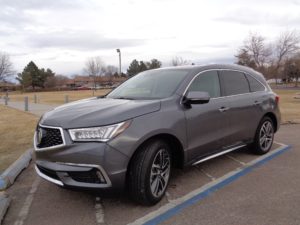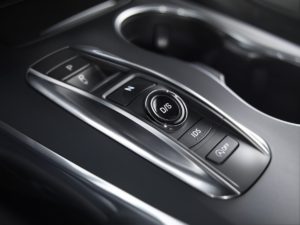Jump head- Hybrid market shows slight gain in ‘16

By Bud Wells
Dating way back to its introduction 16 years ago, the Acura MDX maintains a lofty ranking as one of the most pleasant performers of seven-passenger luxury-model SUVs.
The MDX competes fairly equitably in price, too, with three-row SUV offerings from the Buick Enclave, Infiniti QX60 and Volvo XC90, a tier below the three-row premium luxuries from Mercedes, BMW, Audi and Lexus.
The comfort of its upgraded interior and smoothness of its 290-horsepower, 3.5-liter V-6 engine (no turbocharging) make the MDX review model’s sticker price of $57,340 seem not so out of line, compared with the others.
Did someone say “excellent fuel economy?” I did three years ago when I drove the ’14 version of the MDX up Poudre Canyon and back and averaged an impressive 25.7 miles per gallon.
This one, though, averaged 20.1 in a split of highway cruising and stop-and-go town maneuvers; at that rate, might as well slip a turbo in there and gain some low-end performance. I would expect higher mpg readings, for the MDX’s cylinder deactivation cuts down to use of only three cylinders in coasting, a boost in highway economy.

A new 9-speed automatic transmission was added to the MDX in the past year, mated to the 3.5 V-6, and engaged with use of push-buttons and a pull-switch for reverse. Separate buttons are pushed for Park and Neutral; the most-dominant one is round and lighted and for Drive, of course.
“Sport,” “comfort” and “normal” modes alter throttle response and steering effort, and paddle shifters on the steering wheel hand the driver greater control of gearing shifts in sport mode. The three driving modes are not so noticeably apart in performance as some rival models; Acura maintains its smoothness with all three.
Built in Lincoln, Ala., the Acura weighs a bit less than 4,300 pounds on a wheelbase of 111 inches and overall length of 194.2 inches. Its all-wheel-drive system is capable of accelerating the outer rear wheel faster than the front wheels to help in gaining proper direction of the vehicle. It rides on Continental 245/50R20 tires.
Up-front enhancements of the cabin are heated and cooled, perforated leather seats, neatly stitched with white piping, and wood and chrome trim. A large storage bin is positioned behind well-positioned cupholders in the center console. A dual-screen infotainment system features navigation at the upper display and audio/climate touch controls in the lower. Voice-activation and real-time traffic are included with navigation, and with the audio are ELS Studio, Sirius XM, Pandora and Bluetooth. Steering wheel is heated.
Second-row seating includes a center console between captain chairs, heated, with door sunshades. Push a button on the outside of the second-row seats, they will fold and slide forward to create an opening into the far-back third row, where seating space is somewhat tight.
Behind that back row is 14.9 cubic feet of cargo room, which is smaller than the Enclave, QX60 or XC90. Fold the third row and the Acura expands to 38 cubic feet.
Power moonroof and tailgate and all-round camera view are included in the $57k MKX with AWD and Advance package. Adaptive cruise control and lane-keeping assist are also included.
Hybrids in 2016
Sales of gas/electric hybrids, battery electric vehicles and plug-in hybrids in the past year barely surpassed their 2015 totals in the U.S. market, accounting for approximately 2.9 percent of total new car, SUV and light truck sales for 2016.
Sales of the alternatives went from 498,718 in 2015 to 504,210 in the past year. Seventy-five models recorded sales during the year.
Big gains in ’16 over the previous year were by the Ford Fusion among hybrids, the Tesla S and
X among battery electrics and Chevrolet Volt and Ford Fusion Energi among plug-in hybrids.
The Toyota Prius Liftback, runaway leader in hybrid sales since its introduction in 2000, saw its total for 2016 slip by 13 percent, from 113,829 sales in 2015 to 98,863 the past year. Still, the Prius was more than 50,000 sales ahead of the second strongest seller of hybrids, the Toyota RAV4.
Sales of light-duty diesel models took a sharp drop in 2016, after popular Volkswagen TDIs were taken off the market over an emissions-cheating scandal in September of 2015. Biggest sellers of light-duty diesels the past year were by the Ram 1500 pickup and Ford Transit van.
Top sellers of alternative-fueled vehicles in the U.S. in 2016:
HYBRIDS
Toyota Prius Liftback 98,863; Toyota RAV4 45,070; Ford Fusion 33,648; Toyota Camry 22,227; Toyota Prius C 20,452; Hyundai Sonata 18,961; Toyota Prius V 14,840; Ford C-Max 11,877; Honda Accord 9,179; Lexus CT200h 8,903; Lexus RX400 8,561; Toyota Avalon 8,451; Lexus ES 7,645; Lincoln MKZ 7,219; Kia Optima 6,142; Toyota Highlander 5,976; Chevrolet Malibu 4,335; Lexus NX 2,842; Honda CR-Z 2,338; Subaru XV Crosstrek 2,173.
PLUG-IN HYBRIDS
Chevrolet Volt 24,739; Ford Fusion Energi 15,938; Ford C-Max Energi 7,957; BMW X5 5,995; Audi A3 4,280; Hyundai Sonata 3,000; Toyota Prius Prime 2,474; Porsche Cayenne S E-Hybrid 2,111; Volvo XC90 2,020; BMW i8 1,594.
BATTERY ELECTRICS
Tesla S 29,156; Tesla X 18,028; Nissan Leaf 14,006; BMW i3 7,625; Volkswagen e-Golf 3,937; Fiat 500e 3,897; Kia Soul EV 1,728; Ford Focus EV 872; Smart for Two EV 657; Mercedes B-Class electric 632.
LIGHT-DUTY DIESELS
Ram pickup 55,209; Ford Transit 50,137; Chevrolet Colorado 8,595; Jeep Grand Cherokee 4,253; GMC Canyon 3,936; Range Rover Sport 3,282; Range Rover 2,515; BMW X5 1,725; BMW 3-series 1,462; Jaguar F-Pace 1,044.